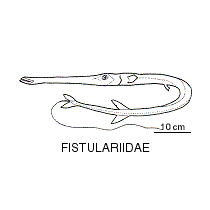- Classification
- ACTINOPTERYGII
- SYNGNATHIFORMES
- FISTULARIIDAE
-
Fish Classification
-
Class
ACTINOPTERYGII Ray-finned fishes -
Order
SYNGNATHIFORMES Seahorses, pipefishes -
Family
FISTULARIIDAE Flutemouths -
Genera
Fistularia(2)
Family FISTULARIIDAE
Medium-sized fishes with a long slender body, a small mouth at the end of a long tubular snout and small sickle-shaped dorsal and anal fins positioned far back on the body. The pelvic fins are abdominal, and the caudal fin is forked with a long filament; fin spines are absent.
These voracious predators rapidly change colour to blend into their surroundings.
More Info
|
Family Taxonomy |
A small family comprising a single genus Fistularia and four to five species. Two species live in Australian waters. |
|
Family Distribution |
Found worldwide in shallow tropical and subtropical waters, from East Africa and the Red Sea to the Gulf of Panama, north to southern Japan and south to Australia. Adults live in coastal and continental shelf habitats ranging from sandy substrates, seagrass beds, coral reefs lagoons and outer reefs, in 0-200 m. Juveniles often live in estuaries and muddy environments. |
|
Family Description |
Meristic features: Dorsal fin rays 14–20; Anal fin rays 14–19; Pectoral fin rays13–18; Pelvic fin rays 5–6; Caudal fin rays 22–24; Vertebrae 76–87; Branchiostegal rays 5. Body very long, slender, tubular and somewhat depressed; snout tubular, mouth small, terminal, oblique; teeth small; barbel absent from chin; circumorbital bones absent. Fin spines absent; soft dorsal and anal fins opposite, well posterior on body; pectoral fins relatively small; pelvic fins abdominal, in anterior half to midway along body; caudal fin forked with middle two rays prolonged to form an elongate caudal filament. Scales absent, body naked or with minute prickles, sometimes with row of scutes on dorsal midline; lateral line arched anteriorly, continuing onto caudal filament. |
|
Family Size |
Although flutemouths reach a total length of 200 cm, most grow up to 1 metre in length; maximum recorded weight is 4.65kg. |
|
Family Feeding |
Voracious ambush predators that rely on stealth and camouflage to hunt small fishes, crustaceans and squids. They feed by repidly sucking prey items in through their long tubular snouts. Like trumpetfishes (family Aulostomidae), they often swim alongside, behind or below larger fishes, or even swim in shadows and hide in fish schools. |
|
Family Reproduction |
The sexes are separate and flutemouths are pelagic spawners. The pelagic eggs and larvae have been described. Settlement stage larvae have not been described. |
|
Family Commercial |
Of no major commercial importance, although flutemouths are often taken in trawls by subsistence fisheries. They are sometimes sold at local markets, either salted, dried or smoked, but are usually reduced to fishmeal. |
|
Family Remarks |
Flutemouths are sometimes seen in small schools, although they are generally solitary. |
|
Author |
Dianne J. Bray |
References
Fritzsche, R.A. 1976. A review of the cornetfishes genus Fistularia (Fistulariidae), with a discussion of intragenetic relationships and zoogeography. Bull. Mar. Sci. 26 (2): 196–204.
Fritzsche, R.A. 1984. Gasterosteiformes: development and relationships, pp. 398–405. In Moser, H.G., W.J. Richards, D.M. Cohen, M.P. Fahay, A.W. Kendall, Jr & S.L. Richardson. (Eds.) 1984. Ontogeny and Systematics of Fishes. American Society of Ichthyologists and Herpetologists, Special Publication 1, Lawrence, Kansas. 760 pp.
Fritzsche R.A. & K.G. Thiesfeld. 1999. Family Aulostomidae, Fistulariidae, Macrorhamphosidae, Centriscidae. pp. 2277–2282 In Carpenter, K.E. & V.H. Niem (eds.) The Living Marine Resources of the Western Central Pacific. FAO Species Identification Guide for Fisheries Purposes. FAO, Rome: Vol 4.
Kuiter, R.H. 1996. Guide to Sea Fishes of Australia. New Holland Press, Sydney. 433 p. figs.
Kuiter, R. H. 2009. Seahorses and their relatives. Aquatic Photographics, Seaford, Australia. 333 p.
Leis, J.M. & D.S. Rennis. 2000. Fistulariidae (Cornetfishes, Flutemouths), p. 207–209, In Leis, J.M. & B.M. Carson-Ewart. (eds.) 2000. The larvae of the Indo-Pacific coastal fishes. An identification guide to marine fish larvae. Brill, Leiden. 850 p.
Michael, S.W. 2001. Reef Fishes Volume 1: A guide to their identification, behaviour and captive care. TFH Publications Inc., New Jersey, USA.
Moser, H.G. (ed.) 1996. The Early Stages of Fishes in the California Current Region. CalCOFI Atlas No.33. Allen Press Inc., Lawrence, Kansas. 1505 pp.
Okiyama, M. (ed.) 1988. An Atlas of the Early Stage Fishes in Japan. Tokai University Press, Tokyo. 1154 pp. [In Japanese]
Paxton, J.R. , J.E. Gates, D.J. Bray & D.F. Hoese. 2006. Gasterosteiformes, In Hoese, D.F., D.J. Bray, J.R. Paxton, G.R. Allen, Beesley, P.L. & A. Wells (Eds). Zoological catalogue of Australia. Volume 35 Fishes. ABRS & CSIRO Publishing, Australia. Part 2.
Randall, J.E., G.R. Allen & R.C. Steene. 1997. Fishes of the Great Barrier Reef and Coral Sea. Bathurst, Australia, Crawford House Publishing.




















